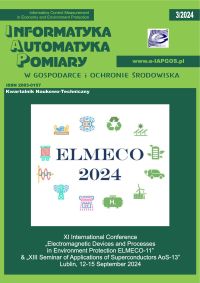ADAPTACYJNY RÓŻNICZKOWY ALGORYTM EWOLUCYJNY ZE STRATEGIĄ DOSTOSOWYWANIA GRANIC DO ROZWIĄZYWANIA NIELINIOWYCH PROBLEMÓW IDENTYFIKACJI PARAMETRÓW
Watchara Wongsa
Khon Kaen University (Tajlandia)
https://orcid.org/0000-0001-6320-149X
Pikul Puphasuk
Khon Kaen University (Tajlandia)
https://orcid.org/0000-0001-9069-1703
Jeerayut Wetweerapong
wjeera@kku.ac.thKhon Kaen University (Tajlandia)
https://orcid.org/0000-0001-5053-3989
Abstrakt
Problemy identyfikacji parametrów w świecie rzeczywistym wymagają określenia granic, które pokrywają nieznane rozwiązania. W artykule przedstawiono adaptacyjny różniczkowy algorytm ewolucyjny ze strategią dostosowywania granic (ADEBAS) do rozwiązywania nieliniowych problemów identyfikacji parametrów. Strategia dostosowywania wykrywa naruszenia granic parametrów zmutowanych wektorów podczas procesu ewolucji i stopniowo rozszerza granice. Algorytm adaptacyjnie wykorzystuje dwie strategie mutacji i dwa zakresy szybkości krzyżowania, aby zrównoważyć różnorodność populacji i szybkość zbieżności. Wyniki eksperymentów pokazują, że ADEBAS może rozwiązać 24 zadania regresji nieliniowej z benchmarku National Institute of Standards and Technology z dokładnym oszacowaniem i niezawodnością. Przewyższa również porównywane metody w rzeczywistych problemach identyfikacji parametrów.
Słowa kluczowe:
parameter identification, differential evolution algorithm, bound adjustment strategyBibliografia
Alam D. F. et al.: Flower pollination algorithm based solar PV parameter estimation. Energy Conversion and Management 101, 2015, 410–422 [http://dx.doi.org/10.1016/j.enconman.2015.05.074].
Google Scholar
Askary R., Najarchi M., Mazaheri H.: Estimating SWRC parameters and unsaturated hydraulic permeability by improved Jaya and hybrid improved jaya optimization algorithms. Earth Science Informatics 15(4), 2022, 2155–2169 [https://doi.org/10.1007/s12145-022-00862-z].
Google Scholar
Barati R.: Parameter estimation of nonlinear Muskingum models using Nelder-Mead simplex algorithm. Journal of Hydrologic Engineering 16(11), 2011, 946–954 [http://doi.org/10.1061/(ASCE)HE.1943-5584.0000379].
Google Scholar
Brooks S. P., Morgan B. J.: Optimization using simulated annealing. Journal of the Royal Statistical Society Series D: The Statistician 44(2), 1995, 241–257.
Google Scholar
Chen X. et al.: Teaching–learning–based artificial bee colony for solar photovoltaic parameter estimation. Applied energy 212, 2018, 1578–1588 [https://doi.org/10.1016/j.apenergy.2017.12.115].
Google Scholar
Gautier M., Janot A., Vandanjon P. O.: A new closed-loop output error method for parameter identification of robot dynamics. IEEE Transactions on Control Systems Technology 21(2), 2012, 428–444 [https://doi.org/10.1109/TCST.2012.2185697].
Google Scholar
Hu Z., Gong W., Li S.: Reinforcement learning-based differential evolution for parameters extraction of photovoltaic models. Energy Reports 7, 2021, 916–928 [https://doi.org/10.1016/j.egyr.2021.01.096].
Google Scholar
Jin J., Gans N.: Parameter identification for industrial robots with a fast and robust trajectory design approach. Robotics and Computer-Integrated Manufacturing 31, 2015, 21–29 [https://doi.org/10.1016/j.rcim.2014.06.004].
Google Scholar
Kennedy J., Eberhart R.: Particle swarm optimization. Proceedings of ICNN'95-international conference on neural networks, 1995, 1942–1948.
Google Scholar
Li S., Gong W., Yan X., Hu C., Bai D., Wang L.: Parameter estimation of photovoltaic models with memetic adaptive differential evolution. Solar Energy 190, 2019, 465–474 [https://doi.org/10.1016/j.solener.2019.08.022].
Google Scholar
Liang J. et al.: Parameters estimation of solar photovoltaic models via a self-adaptive ensemble-based differential evolution. Solar Energy 207, 2020, 336–346 [https://doi.org/10.1016/j.solener.2020.06.100].
Google Scholar
Mohan S.: Parameter estimation of nonlinear Muskingum models using genetic algorithm. Journal of hydraulic engineering 123(2), 1997, 137–142 [https://doi.org/10.1061/(ASCE)0733-9429(1997)123:2(137)].
Google Scholar
Nemes A. D. et al.: Description of the unsaturated soil hydraulic database UNSODA version 2.0. Journal of hydrology 251(3-4), 2001, 151–162.
Google Scholar
Price W. L.: A controlled random search procedure for global optimisation. The Computer Journal 20(4), 1977, 367–370.
Google Scholar
Puphasuk P., Wetweerapong J.: An enhanced differential evolution algorithm with adaptation of switching crossover strategy for continuous optimization. Foundations of Computing and Decision Sciences 45(2), 2020, 97–124 [https://doi.org/10.2478/fcds-2020-0007].
Google Scholar
Salhi H., Kamoun S.: A recursive parametric estimation algorithm of multivariable nonlinear systems described by Hammerstein mathematical models. Applied Mathematical Modelling 39(16), 2015, 4951–4962 [https://doi.org/10.1016/j.apm.2015.03.050].
Google Scholar
Singsathid P., Wetweerapong J., Puphasuk P.: Parameter estimation of solar PV models using self-adaptive differential evolution with dynamic mutation and pheromone strategy. Computer Science 19(1), 2024, 13–21.
Google Scholar
Storn R., Price K.: Differential evolution–a simple and efficient heuristic for global optimization over continuous spaces. Journal of global optimization 11, 1997, 341–359 [http://doi.org/10.1023/A:1008202821328].
Google Scholar
Tvrdík J., Křivý I., Mišík L.: Adaptive population-based search: application to estimation of nonlinear regression parameters. Computational statistics & data analysis 52(2), 2007, 713–724 [https://doi.org/10.1016/j.csda.2006.10.014].
Google Scholar
Wang D. et al.: Heterogeneous differential evolution algorithm for parameter estimation of solar photovoltaic models. Energy Reports 8, 2022, 4724–4746 [https://doi.org/10.1016/j.egyr.2022.03.144].
Google Scholar
Wang L., Huang C., Huang L.: Parameter estimation of the soil water retention curve model with Jaya algorithm. Computers and Electronics in Agriculture 151, 2018, 349–353 [https://doi.org/10.1016/j.compag.2018.06.024].
Google Scholar
Whitley D.: A genetic algorithm tutorial. Statistics and computing 4, 1994, 65–85.
Google Scholar
Xu L.: The damping iterative parameter identification method for dynamical systems based on the sine signal measurement. Signal Processing 120, 2016, 660–667 [https://doi.org/10.1016/j.sigpro.2015.10.009].
Google Scholar
Yang X., You X.: Estimating parameters of van Genuchten model for soil water retention curve by intelligent algorithms. Applied Mathematics & Information Sciences 7(5), 2013, 1977–1983.
Google Scholar
Yu K. et al.: A performance-guided JAYA algorithm for parameters identification of photovoltaic cell and module. Applied Energy 237, 2019, 241–257 [https://doi.org/10.1016/j.apenergy.2019.01.008].
Google Scholar
Zhang J., Wang Z., Luo X.: Parameter estimation for soil water retention curve using the salp swarm algorithm. Water 10(6), 2018, 815 [https://doi.org/10.3390/w10060815].
Google Scholar
Zhou J. et al.: Parameters identification of photovoltaic models using a differential evolution algorithm based on elite and obsolete dynamic learning. Applied Energy 314, 2022, [https://doi.org/10.1016/j.apenergy.2022.118877].
Google Scholar
National Institute of Standards and Technology. Nonlinear regression, 2003 [https://www.itl.nist.gov/div898/strd/nls/nls_info.shtml].
Google Scholar
Autorzy
Jeerayut Wetweerapongwjeera@kku.ac.th
Khon Kaen University Tajlandia
https://orcid.org/0000-0001-5053-3989
Statystyki
Abstract views: 103PDF downloads: 79
Inne teksty tego samego autora
- Saithip Limtrakul, Jeerayut Wetweerapong, ULEPSZONY ALGORYTM EWOLUCJI RÓŻNICOWEJ Z ADAPTACYJNYMI GRANICAMI WAG DLA EFEKTYWNEGO SZKOLENIA SIECI NEURONOWYCH , Informatyka, Automatyka, Pomiary w Gospodarce i Ochronie Środowiska: Tom 13 Nr 1 (2023)









